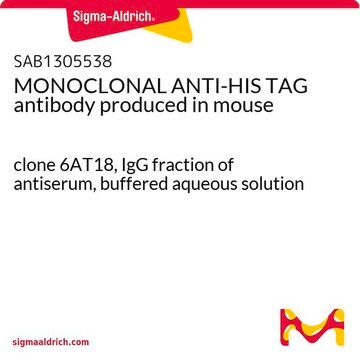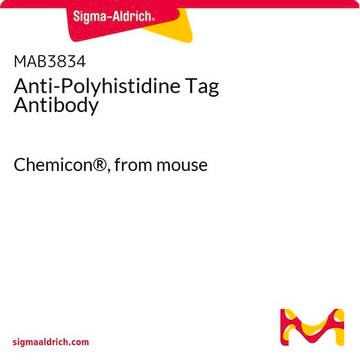The detection limit of product H1029 is 0.5 μg/ml or less.
Kluczowe dokumenty
H1029
Monoclonal Anti-polyHistidine antibody produced in mouse
clone HIS-1, ascites fluid
Synonim(y):
Monoclonal Anti-polyHistidine, Monoclonal 6 His epitope tag, Monoclonal 6xHis-tag, Monoclonal HHHHHH epitope tag, Monoclonal Hexa His tag, Monoclonal His-tag, Monoclonal His6 tag, Monoclonal Histidine tagged, Monoclonal Poly-His-tag
Wybierz wielkość
2320,00 zł
Wybierz wielkość
About This Item
2320,00 zł
Polecane produkty
pochodzenie biologiczne
mouse
Poziom jakości
białko sprzężone
unconjugated
forma przeciwciała
ascites fluid
rodzaj przeciwciała
primary antibodies
klon
HIS-1, monoclonal
Formularz
liquid
metody
dot blot: suitable
immunoprecipitation (IP): suitable
indirect ELISA: suitable
western blot: 1:3,000 using lysates of Escherichia coli induced to express a 6xHis tagged protein
izotyp
IgG2a
Warunki transportu
dry ice
temp. przechowywania
−20°C
docelowa modyfikacja potranslacyjna
unmodified
Szukasz podobnych produktów? Odwiedź Przewodnik dotyczący porównywania produktów
Opis ogólny
Specyficzność
Immunogen
Zastosowanie
Działania biochem./fizjol.
Postać fizyczna
Inne uwagi
Informacje prawne
Nie możesz znaleźć właściwego produktu?
Wypróbuj nasz Narzędzie selektora produktów.
Kod klasy składowania
10 - Combustible liquids
Klasa zagrożenia wodnego (WGK)
WGK 1
Wybierz jedną z najnowszych wersji:
Certyfikaty analizy (CoA)
Nie widzisz odpowiedniej wersji?
Jeśli potrzebujesz konkretnej wersji, możesz wyszukać konkretny certyfikat według numeru partii lub serii.
Masz już ten produkt?
Dokumenty związane z niedawno zakupionymi produktami zostały zamieszczone w Bibliotece dokumentów.
Klienci oglądali również te produkty
-
What is the detection limit of Product H1029, Monoclonal Anti-polyHistidine antibody?
1 answer-
Helpful?
-
-
Is Product H1029, Monoclonal Anti-polyHistidine antibody, suitable for use in immunofluorescence studies?
1 answer-
Product H1029 has been used in immunofluorescence and a good picture of the staining has been published. Ker R. Marshall, et al., Journal of General Virology 83, 1601-1612 (2002).
Helpful?
-
-
How many histidines are required for proper recognition by Product H1029, Monoclonal Anti-polyHistidine antibody?
1 answer-
Product H1029, Monoclonal Anti-polyHistidine antibody requires at least 6 histidines in a row for recognition.
Helpful?
-
Active Filters
Nasz zespół naukowców ma doświadczenie we wszystkich obszarach badań, w tym w naukach przyrodniczych, materiałoznawstwie, syntezie chemicznej, chromatografii, analityce i wielu innych dziedzinach.
Skontaktuj się z zespołem ds. pomocy technicznej













